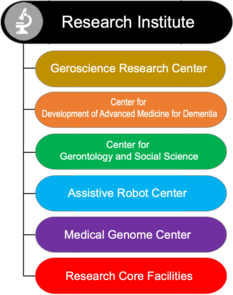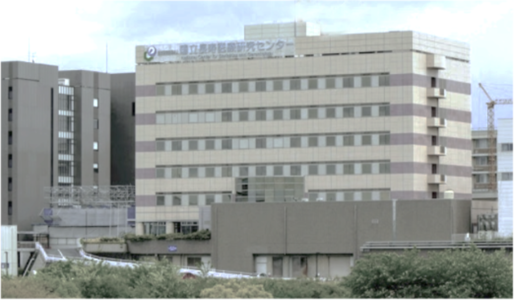About Us
Welcome to our Research Institute Website.
The number of Japanese elderly with ages 65 or older was 36.4 million in 2021, accounting for 29.1% of Japan’s population. The Government estimates that Japan's elderly will make up 35.3 percent by 2040. As the proportion of the elderly in the population has increased, the disease structure of society has changed dramatically, geriatric diseases including dementia, sarcopenia, and frailty have come to limelight.
Protecting physical and mental health in elderly citizen has become one of the most important national policies, involving not only the medical field but also the nursing and welfare fields. Our Research Institute aim to investigate, research, and develop technologies for diseases associated with aging and to contribute to solving health problems faced by the aging society.
The Research Institute was established in 2004 as a research division of the National Center for Geriatrics and Gerontology (NCGG), the 6th National Center in Japan. The predecessor of the Research Institute was the National Institute of Longevity Science, established as a part of Chubu National Hospital in 1995. Since then, it has undergone several changes, including becoming an Incorporated Administrative Agency.
To maximize efficiency and effectiveness for our mission, we reorganized the Institute in 2021.The Research Institute has five research fields and core-facilities (see below). We concentrate and efficiently promote research that contributes to the "healthy longevity," or the extension of the period during which the elderly can live in good health. Activity of each research center is as below.
On the other hand, the Institute is also promoting biobank projects. Biobanks have been recognized as an important research platform for medical research and are now being established all over the world. Due to the international spread of biobanks, the ISO international standard for biobanking was issued in 2018. We are preparing to obtain a certification for biobanking.
At the same time, we are working on building a foundation for genomic medicine. As personalized medicine and precision medicine for diseases are flourishing, diagnosis and treatment based on genome information are expected in the field of geriatrics as well. At our institute, genome analysis focusing on dementia has been advanced, and genetic information of 30,000 individuals has already been collected. This genomic information together with samples from the biobank, are now available for secondary use by researchers in Japan and overseas. It is no exaggeration to say that our institute is the research base of geriatrics research in Japan.
All of us at the Research Institute are determined to contribute to the maintenance of the health of the elderly through our research activities.
Director-General of Research Institute
Shumpei Niida, Ph.D.
The Research Institute has five research fields and core-facilities. Activity of each research center is as below.
GSRC conducts research on aging-related physical changes and pathophysiology of diseases that can be applied to clinical practice.
CAMD conducts research and development aimed at the advanced and practical application of prevention, diagnosis, treatment, nursing care and support for dementia.
CGSS conducts empirical research to clarify the scientific basis for planning health, medical, and welfare policies for the elderly.
ARC promotes engineering research and supports robot development in the field of longevity medicine, including not only the elderly but also caregivers.
MGC is engaged in the development of infrastructure for genomic medicine and genomic medical science research on geriatrics diseases. It also operates the biobank project.
RCF is responsible for the development of cutting-edge research technologies and the management of the latest equipment to support the five research centers.


|
July, 1995. |
Research Institute of Longevity Science was established as a part of Chubu National Hospital. |
|---|---|
|
March, 2004 |
National Center for Geriatrics and Gerontology (NCGG) Research Institute was established. |
|
April, 2010. |
NCGG’s status changed to Incorporated Administrative Agency. Center for Development of Advanced Medicine for Dementia (CAMD) was established. |
|
April, 2012. |
Center for Gerontology and Social Science (CGSS) was established. |
|
April, 2015. |
NCGG’s status changed again to National Research and Development Agency. Center of Assistive Robotics and Rehabilitation for Longevity and Good Health was established. |
|
October, 2015. |
Medical Genome Center (MGC) was established. |
|
April, 2021. |
Reorganization of Research Institute. Four Research Centers were merged into the Research Institute. |